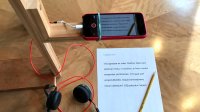Bringing More of a Classroom Feel to Distance Learning
Through technology, teachers can share the sights and sounds of the classroom to help remote students feel more connected.
Your content has been saved!
Go to My Saved Content.Your students want to see your eyes, hear your voice, watch what your hands are doing, and know your heart. All of that is difficult at the moment, but remote learning has presented us with a perfect example of how constraints such as not being in the same room together can unleash creativity.
I use recordings of slide deck presentations for the focused, four-to-five-minute lectures I give, but I use them sparingly whether instruction is in person or remote. And if the learning is remote, I always use Loom, free screen and video recording software, which captures not only my presentation and my voice but also my eyes. As teachers, we all like to see our students’ eyes. They want to see ours, too.
My students tell me that while the slide deck lessons are clear and helpful, they like to see me write on the board. They find that they remain engaged by tracking my hand and that they like it when my voice is coming from where the image is being produced. With slide decks, one must stand to the side to present.
A Setup Inspired by Salman Khan
I use a plain dry-erase board most of the time. Several years ago I salvaged an old slate chalkboard from a classroom renovation at another school and kept it in my basement. But last year I got it to my classroom with a little help and convinced Plant and Operations to hang it in my room. The students were fascinated and drew all over it. The slate board provides welcome variety during presentations. My students like the white writing on a black, matte background instead of colored writing on a white, shiny background. The slate board also emits its distinctive tapping sound, which is reproduced in Salman Khan’s Khan Academy lessons. I now use a sampled image of the slate surface as the background to my slide decks, evoking tactile memories in my remote students.
During quarantine, I wanted to respond somehow to my students’ expressed desire to watch me write. I printed out a snippet of text that I wanted to explicate and annotate in a large font, double-spaced. I put my phone on top of a stack of books and began recording as I annotated the piece of text with a pencil. I made a mistake and used the eraser. It was simple, human, and basic, and my students loved it.
Using a Simple Rig to Better Connect With Students
From some random lumber I had in the basement, I built a very simple rig to hold my phone a few inches above a table. I put a large rock on the base to keep it from tumbling over, and I used a rubber band to secure the phone. I drilled several screw holes in the vertical beam so that I could adjust the height of the horizontal platform that held the phone. This gave me the ability to get the right focal distance from my workspace. I didn’t want the font to appear too small, but I needed the phone to have enough elevation for me to write and point. I am right-handed, and I wear a silver ring showing the Pueblo symbols for sun and rain on that hand. I noticed while reviewing my videos that the ring provided interest and individuality.
I plugged an inexpensive headset with a decent mic into the phone and got excellent, FM-radio-quality sound on the recordings. I kept the lessons under seven minutes—most of them clocked in at about four minutes.
I always found it curious that Khan Academy’s signature look and feel was chalk on a blackboard with the tap, tap, tap of the chalk hitting the board and the slowly revealed, hand-drawn lines along with the soft voice of the one who was drawing. I cannot seem to capture the sound of my pencil on the paper, but my students can see my hand drawing, writing, and pointing. They also hear my voice as though they were sitting beside me.
I edit my lessons on the phone and then upload them to YouTube. We use Canvas as our learning management system, and it’s easy to embed the video into a Canvas assignment using the embed code. The end result is an uncanny combination of slick production value and homey, handcrafted, artisanal teaching. It’s unique, deeply personal, and from the heart. I let them know how I approach a piece of text, how I read, how I write, how I speak, and how I feel about the text. They then take that with them into their breakout rooms to do their own work.
When I visit them in their groups, I have a rule: Listen forever. If a student wants me to listen to a rant about tech problems, I listen. They may say they have questions, but they really just want to talk through their ideas. I listen. Whatever they want to say, they can say, and I stay quiet. In this way, I give them my ears as well. I get to know them just as I let them know me.
You need to be a person in class to make learning personal, and you need to be your own author if you want to be authentic. Show your students your own, authentic work with all of its flaws and brilliance. Speak personally about the things that interest you in the material, and speak passionately about the things that interest you and you alone. We are at our best when we express what is unique and peculiar about us in our teaching.
